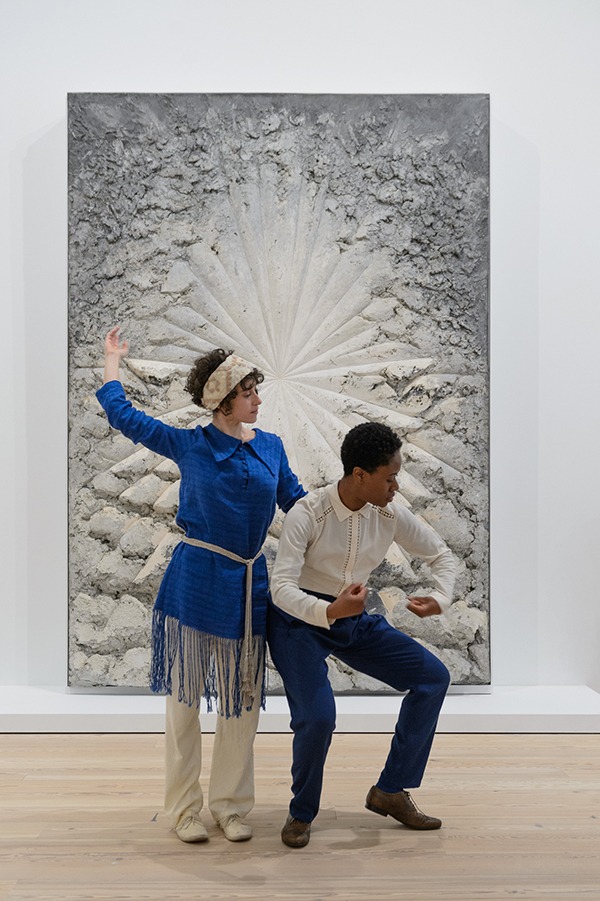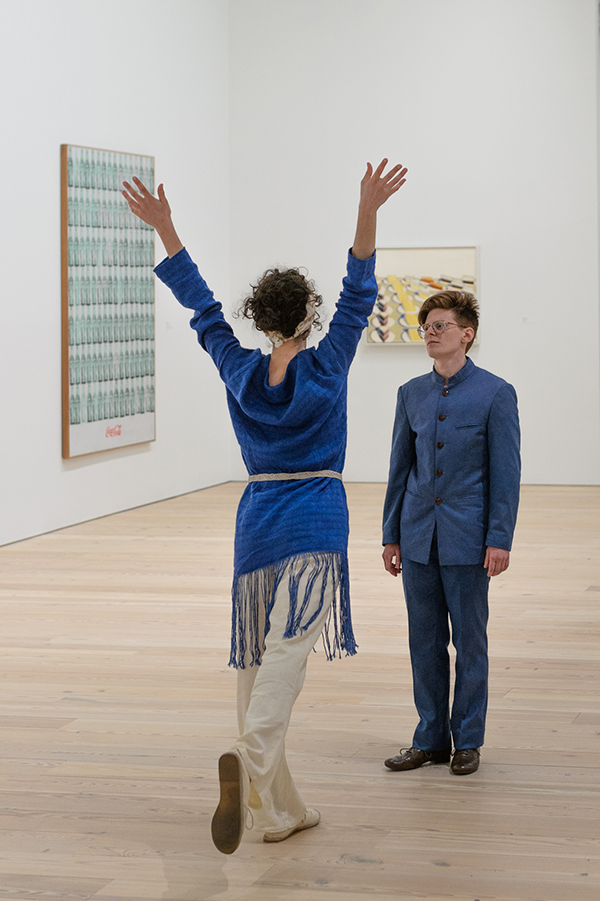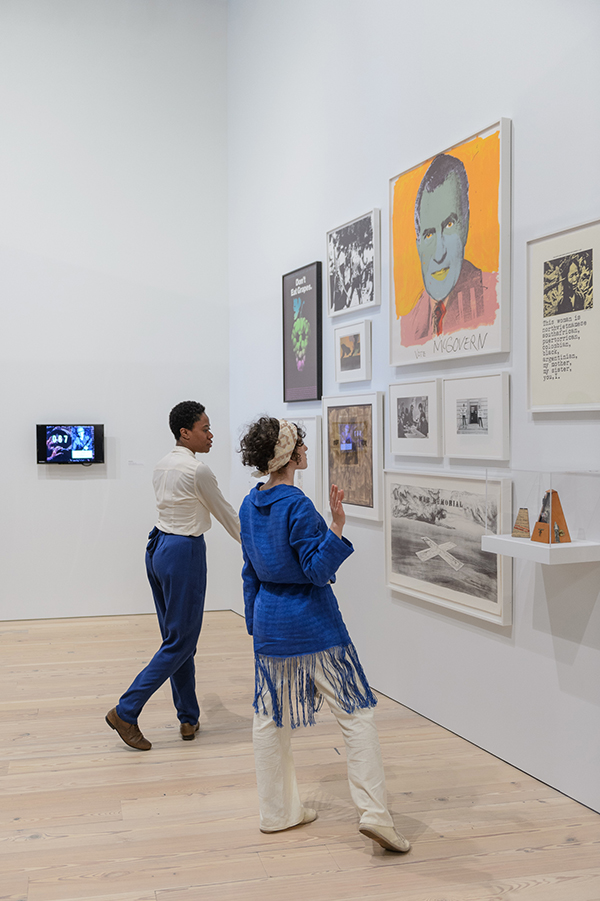


photocredit: Filip Wolak
Performance Whitney Museum of American Art, May 13-18th, 2015



photocredit: Filip Wolak
Performance Whitney Museum of American Art, May 13-18th, 2015
8th FLOOR / STORY 1 / Forms Abstracted
Jess stands next to the Elisabeth Prophet head.
Lily stands in front of the Georgia O’Keeffe.
Omagbitse stands in front of the Stuart Davis Egg Beater.
To get attention performers shout out names in no specified order:
Jess: Jess, Marsden
Lily: Lily, Georgia
Omagbitse: Omagbitse, Elisabeth, Isamu
Lily and Omagbitse duet infront of O’Keeffe.
Jess: Art needs the layman, it needs their opinions, their backing and their criticism. Expert advice is good, but it is not enough. Juliana Force, who would become the first director of the museum, was born in Pennsylvania and lived with her ailing mother and sisters in New Jersey. She did not have much of an in depth education but an uncontainable drive for independence. She became a social secretary and was recommended to Gertrud Vanderbilt Whitney through a relative.
Born only a year apart from each other Juliana and Gertrude were an unlikely pair in social standing, in temper. Yet they both shared an interest in literature and a talent to write, which was Gertrude’s first passion. They also shared an untethered determination that women can and should achieve things beyond the limitations of their social standing. Trying to get Gertrude’s writing published was Juliana’s first task to which she committed herself full heartedly, jet without much success.
Despite those early disappointments, Gertrude instantly recognized that she had found an enthusiastic supporter who engaged her ambitions without judgment. Focusing on her career as an artists, Juliana helped her to entertain and support the new found community, through exhibitions, acquisitions and loans. Artist first. A club to support their making. Exhibitions were held, diletantly at first, then better and better. No criticism and highbrowed arrogance kept these women from persuing their ideals. Collecting was started to support the artist’s financial and moral needs, not to create a masterpiece collection. They collected and preserved for us today what was there, a context, a community of American artists.
The next step was to create an institution and therefore a history for those artists. Elisabeth Prophet of Native and African American heritage — who said, poverty is the course of genius — in 1922 received financial support from Juliana and Gertrude to study in Paris for example. And Juliana purchased this sculpture for the museum when Prophet returned to the U.S. This extraordinary vision preserved one of the few pieces of this extraordinary body of work.
It is comfortable for us to look today at collections and simply trusting the decision that formed them. Yet we all know how foolish that would be. This museum should exists today as an expression of the principles established during those early years: that an institution, to be alive, must have a vital relation to the art and to the artists of its own country and period. I believe that this principle in its embrace and its ignorance has had a deep and widespread influence on American art.
FLOOR 7 / STORY 4 / Fighting with all their Might
Stands in front of the Ben Shahn.
Lily in front of Alice Neel painting.
Omagbitse in front of Jacob Lawrence.
To get attention performers shout out names in no specified order:
Jess: Ben, Margaret
Lily: Mable, Dorothea,
Omagbitse: Jacob, Bernarda, Alice
Lily and Omagbitse duet in front Lawrence War Series.
Art lives in paradoxes —on the one hand taking measure of our anxieties of loss, collecting histories of pain, marking them persistently in culture to remember, more often then not against the grain. At the same time this art teases out possibilities, asking what those losses may release us to imagine right now.
But one could ask what else could be intended than anarchy or free fall when we attempt to destabilize history? Times of understanding history as unified in a singular story of progress are long gone. “Other” histories continue to emerge around us, claiming space, claiming minds, like cracks in a pavement. While the past becomes less easily reduced to a single set of meanings and effects, the present is now forced to orient itself amid so much history and so many histories. Yet even with our feet standing on such upheaved grounds, there is an undeniable persistent longing for the master narrative, master history, the master, genius, white god, men. We have not jettisoned them as a source of political motivation or as sites of collective loyalty.
The future might appear to you more uncertain, less predictable, and perhaps even less promising than the one figured by the terms of modernism. But for some of us we see that these disruptions suggest in the present a porousness and uncharted potential that can lead to futures outside the lines of modernist presumptions. Pause.
This is where art begins.
FLOOR 5 / STORY 9 / Learn Where the meat comes from & Hans Haacke
Jess stands in front of the Dorothea Rockburne.
Lily stands in front of Ana Mendieta.
Omagbitse stands in front of the Cindy Sherman
To get attention performers shout out names in no specified order:
Jess: Hans, Dorothea, Jess, Martha
Lily: Joan, Hannah, Francesca, Asco, Howardina, Suzanne, Sylvia, Lily
Omagbitse: Ana, Cindy, Laurie, Hermine, Cynthia, Eleanor, Liliana, Omagbitse,
Lily and Omagbitse duet btw Ana Mendieta and Vertical Roll. Improv/Choreography: Hans Haacke
When it comes to art, why still talk about women? Queer? Transgender? Native-American? African-American? Latino? Asian-American? Why disenfranchised? Working class? Less privileged? Differently educated? I sometimes can’t believe, I still need to ask these questions, ask them here with you. Given we all live in the same world. Or do we? Believe me, I am not interested in statistics, in feel good numbers equated by reason. The truth is, what I am interested in is the fact that we don’t know the potential of these words, these classifications, these identities in this country until many more who are described as such are rendered visible to culture, to politics, to the everyday and the latent sensibility that comes from those positions can be recognized at large. What would happen if all of us could be turned on, infatuated, guided and lead by the thought, that art, that dormant reason of women, queer, Transgender, Native-American, African-American, Latino, Asian-American, disenfranchised, working class, less privileged in the same way we have been turned for centuries by a dominant culture which is widely exposed?
FLOOR 5 / STORY 10 / Love Letter From The War Front
Jess stands in front of the Peter Hujar.
Lily stands in front of Felix.
Omagbitse stands in front of Kiki Smith.
To get attention performers shout out names in no specified order:
Jess: Felix, Robert, Martin
Lily: David, Robert, Kiki
Omagbitse: Mark, Nan, Sue, Peter
Lily and Omagbitse duet in front of the Felix and Peter Hujar in his deadbeth.
You are welcome to keep your body. I would rather have my mind and soul. (1)
Curate the sound you make by jumping. Flap your hands before your eyes. In lengthening, become from another country. Imitate the movement but expel more air. Say this is your house and run a lap in it but dance with the air immediately around the ones who seem to stay there. Repeat a word or a phrase, slightly louder, up three steps then down, like a color block in a Hoffman Painting. For a minute say every word but slowly. Hold someone else’s hand up to your ear. (2)
FLOOR 5 / STORY 12 / Course of Empire
Jess stands underneath Glenn Ligon’s America.
Omagbitse stands in front of Alexandra Mir.
Lily stands in front of wall with many pictures.
To get attention performers shout out names in no specified order:
Jess: Glenn, Dread,
Lily: Elizabeth, Zoe, Abelardo, Huma, Robert
Omagbitse: Alecsandra, Ann, Taryn, An-My, La Toya, Wayne
Lily and Omagbitse duet in front of Glenn’s America.
Let me first say it is ah, its a privilege for me to be here, in this beautiful new space for this great American Museum. It is truly an honor.
I cannot think of a better theme for this inaugural show then “America is hard to See” Cause that title isn’t just a statement of fact, it’s a challenge that the Whitney has embraced with open arms, the challenge of truly seeing America in all of its glory and complexity. With this exhibit, all of you have asked the question of how can we truly fully witness the melting pot of culture and sensibility and struggle that make America unlike any other country on earth. This is a bold, very hard question. And this exhibit isn’t trying to provide any kind of definitive answer, instead its doing something even more important. Its inviting us to answer this question for ourselves. Each of us reflecting and rethinking our assumptions as we walk through these galleries. And I think that will be an incredibly powerful experience for anyone who comes here to visit.
But it will be particularly powerful for our young people. You see, there are so many kids in this country who look at places like museum and concert halls other cultural centers and they think to themselves, well that is not a place for me. For someone who looks like me. For someone who comes from my neighborhood. In fact I guarantee you that right now, there are kids living less then a mile from here who would never in a million years dream that they would be welcome in this museum. And growing up in the south side of Chicago, I was one of those kids myself. So I know the feeling of not belonging in a place like this.
And today as First Lady I know how that feeling limits the horizon of far too many of our young people. But we should invite our young people to be inspired by artist and start dreaming, just a little bigger, start reaching just a little hire for yourself. And with this inaugural exhibition, the Whitney is sending this message to young people and the people of every background across this country. You are telling them that their story, is part of the American story. And that they deserve to be seen.
One visit, one performance, one touch and who knows how you can spark a child’s imagination and maybe you can inspire a young person to rise above the circumstances of their life and reach for something better. Maybe you could discover the next Carmen Herrera or the next Archibald Motley or the Edward Hopper, or the next Barack Obama. That is the power of institutions like this. (3)
(1) Elisabeth Prophet, diaries
(2) Fred Moten
(3) excerpts from Michelle Obama’s dedication speech of the Whitney Museum of American Art, April 30th, 2015